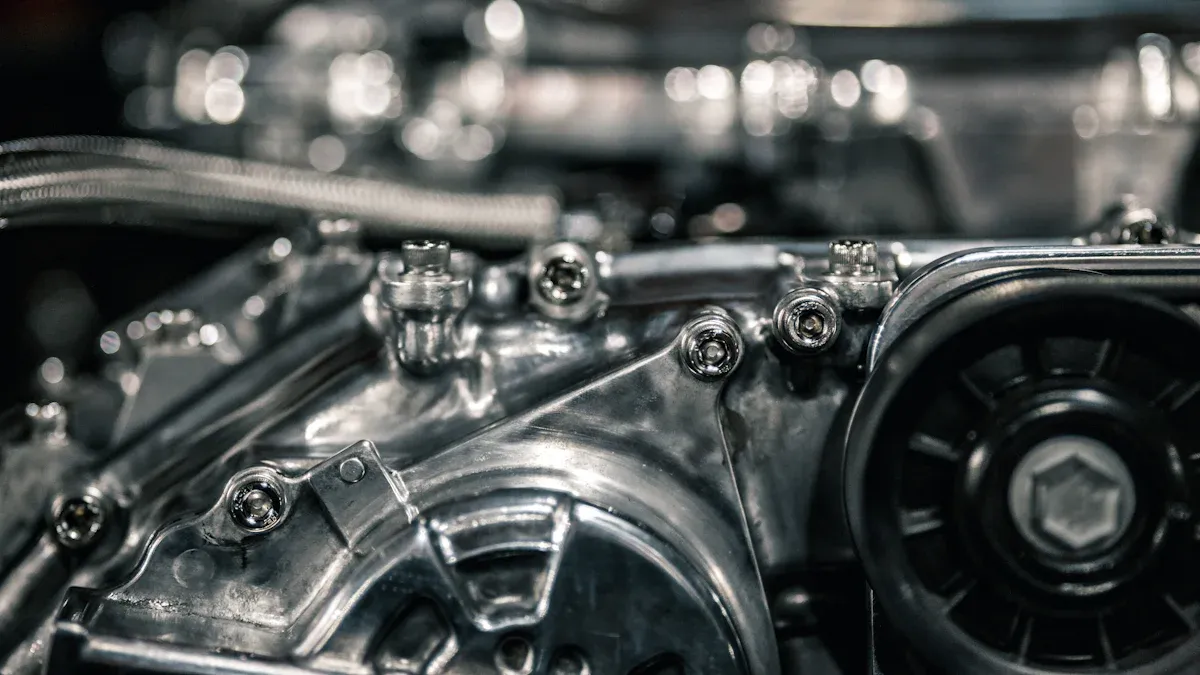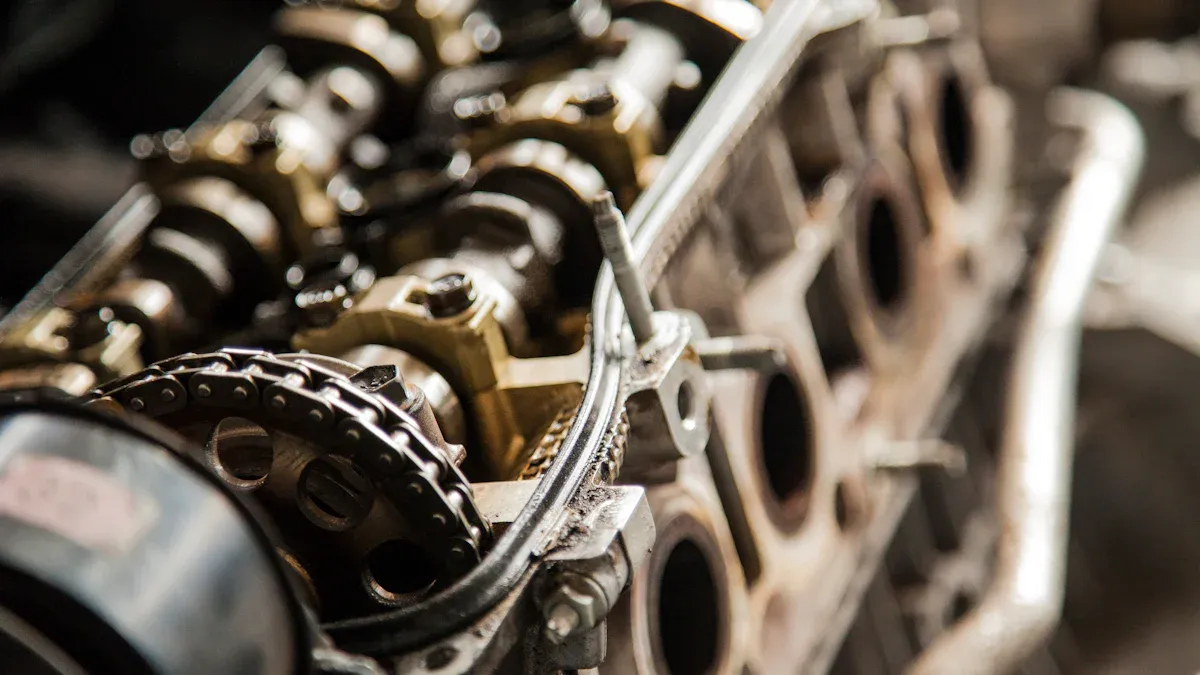Keeping your piston rod clean is crucial for maintaining its optimal condition. Accumulated dirt and debris can lead to scratches and increased wear, ultimately diminishing its performance over time. Regular cleaning eliminates harmful contaminants and helps guard against corrosion, which can compromise the strength of the rod. By establishing consistent maintenance practices, you safeguard your equipment and ensure it functions efficiently. A well-maintained piston rod not only has a longer lifespan but also helps you avoid expensive repairs. Proper care today ensures fewer issues in the future.
Why Cleaning Matters for Piston Rods
Effects of Dirt and Debris on Performance
Dirt and debris can significantly impact the performance of your piston rod. When contaminants accumulate, they create an abrasive environment that wears down the surface of the rod. This wear can lead to scratches, which reduce the smoothness required for efficient operation. Over time, these imperfections increase friction, causing the rod to work harder and less efficiently.
Small particles can also infiltrate the bearing environment. These particles may deform the bearings, leading to overheating and premature failure. Additionally, contaminants can form high spots on the bearings. These high spots can scratch the crank journal, displacing material and further damaging the system. Keeping the piston rod clean prevents these issues and ensures smooth, reliable performance.
Role of Cleaning in Preventing Corrosion
Corrosion is one of the most common threats to the longevity of a piston rod. Moisture, combined with dirt or other contaminants, creates the perfect conditions for rust to form. Rust weakens the rod’s structure and compromises its ability to handle stress. Regular cleaning removes moisture and debris, reducing the risk of corrosion.
By using appropriate cleaning solutions, you can also add a protective layer to the rod’s surface. This layer acts as a barrier against environmental factors like humidity and temperature changes. A clean and protected piston rod is less likely to corrode, ensuring it remains strong and functional for a longer time.
Long-Term Benefits of Maintenance
Consistent cleaning and maintenance offer long-term benefits that go beyond immediate performance. A clean piston rod experiences less wear and tear, which extends its lifespan. This reduces the need for frequent replacements, saving you money in the long run. Proper maintenance also minimizes the risk of unexpected breakdowns, keeping your equipment operational when you need it most.
Additionally, a well-maintained piston rod contributes to the overall efficiency of your machinery. When the rod operates smoothly, it reduces strain on other components, improving the performance of the entire system. By investing time in regular cleaning, you ensure your equipment remains reliable and cost-effective.
Essential Tools and Materials for Cleaning Piston Rods

Recommended Cleaning Solutions
Choosing the right cleaning solution is essential for maintaining the condition of your piston rod. Avoid harsh chemicals that can damage the rod’s surface. Instead, opt for solutions specifically designed for metal components. These cleaners effectively remove dirt, grease, and other contaminants without causing harm. Look for products labeled as non-corrosive or safe for use on steel and chrome surfaces.
For stubborn grime, degreasers can be highly effective. They break down oil and grease, making it easier to wipe away residues. If you prefer eco-friendly options, consider water-based cleaners. These are safer for the environment and still provide excellent cleaning power. Always follow the manufacturer’s instructions to ensure proper application and avoid overuse.
Brushes, Cloths, and Applicators
The tools you use for cleaning play a significant role in achieving the best results. Soft-bristled brushes are ideal for scrubbing away dirt without scratching the rod’s surface. Nylon or natural bristles work well for this purpose. For more delicate areas, microfiber cloths are a great choice. They trap dust and debris while being gentle on the metal.
Applicators like foam pads or sponges can help you evenly distribute cleaning solutions. These tools ensure that every part of the piston rod gets treated. Avoid using abrasive materials like steel wool, as they can leave scratches and weaken the rod over time. Keeping a variety of brushes and cloths on hand allows you to tackle different cleaning tasks effectively.
Protective Gear for Safe Handling
Safety should always be a priority when cleaning piston rods. Using protective gear shields you from potential hazards during the process. Operators handling high-pressure cleaning tools must wear protective clothing to prevent injuries. Materials like canvas or leather provide excellent coverage for your body, hands, arms, legs, and feet.
A respirator is also essential if you’re working with abrasive cleaning methods or strong chemicals. It protects your lungs from harmful particles and fumes. Safety goggles and gloves add an extra layer of protection, ensuring your eyes and skin remain safe. By wearing the right gear, you can clean your piston rod confidently and without risk.
Tip: Always inspect your protective gear for damage before starting. Worn-out equipment may not provide adequate protection.
Step-by-Step Cleaning Techniques for Piston Rods

Preparing the Rod for Cleaning
Before cleaning your piston rod, ensure the workspace is clean and organized. A clutter-free environment reduces the risk of contamination during the process. Begin by removing the rod from its housing or machinery, if applicable. This step allows you to access all surfaces and inspect the rod thoroughly.
Use a soft brush or compressed air to remove loose dirt and debris from the rod’s surface. Pay close attention to grooves, seals, and other intricate areas where contaminants tend to accumulate. If the rod is heavily soiled, rinse it with clean water to loosen stubborn grime. Dry the rod immediately with a lint-free cloth to prevent moisture from causing corrosion.
Tip: Always handle the piston rod with clean gloves to avoid transferring oils or dirt from your hands onto the metal surface.
Applying Cleaning Agents Effectively
Applying cleaning agents correctly ensures thorough removal of contaminants without damaging the piston rod. Choose a cleaning solution designed for metal components, such as a non-corrosive degreaser or water-based cleaner. Pour a small amount of the solution onto a foam applicator or microfiber cloth.
Work the cleaning agent into the rod’s surface using gentle, circular motions. This technique helps lift dirt and grease while minimizing the risk of scratches. For hard-to-reach areas, use a soft-bristled brush to distribute the solution evenly. Avoid over-saturating the rod, as excess liquid can seep into seals and cause damage.
A study on cleaning devices highlights the benefits of continuous irrigation systems, such as the special continuous douche. These systems improve cleaning efficiency and reduce contamination risks by using one-way valves. While not always necessary for piston rods, adopting similar principles—like controlled application—can enhance your cleaning outcomes.
Note: Allow the cleaning agent to sit for a few minutes to break down stubborn residues before wiping it off.
Removing Residue and Polishing
After applying the cleaning agent, remove all residues to ensure the piston rod is spotless. Use a clean microfiber cloth to wipe away the solution, working in straight lines to avoid streaks. For stubborn residues, rinse the rod with clean water and dry it thoroughly.
Polishing the rod adds a protective layer and restores its smooth finish. Apply a small amount of metal polish to a foam pad or cloth. Buff the rod’s surface using light pressure and circular motions. This step not only enhances the rod’s appearance but also reduces friction during operation.
Experimental data shows that polishing textured surfaces can significantly reduce friction and wear. For example:
- A coupling-textured surface reduced friction by 27.9% and wear by 30.0% under a normal load of 10 N.
- Compared to single-textured surfaces, friction decreased by 18.9%, and wear dropped by 23.8%.
Polishing helps capture wear debris and improves the formation of lubricant films, extending the life of your piston rod.
Tip: Inspect the rod for scratches, dents, or other damage during polishing. Early detection allows you to address issues before they worsen.
Inspecting for Damage During Cleaning
Inspecting your piston rod for damage during cleaning is a critical step in maintaining its performance and longevity. Cleaning provides the perfect opportunity to examine the rod closely, as dirt and grime can often hide signs of wear or damage. By identifying issues early, you can prevent costly repairs and ensure your equipment operates efficiently.
What to Look For
When inspecting the piston rod, focus on the following areas:
- Surface Scratches or Scuffs: Look for visible scratches, scuffs, or abrasions. These imperfections can increase friction and reduce the rod’s efficiency.
- Corrosion or Rust: Check for any signs of rust, especially in areas where moisture may have been trapped. Corrosion weakens the rod and can lead to structural failure.
- Bent or Warped Sections: Roll the rod on a flat surface to check for bends or warping. A bent rod can cause misalignment and damage other components.
- Seal Integrity: Inspect the seals for cracks, tears, or wear. Damaged seals can allow contaminants to enter, leading to further issues.
Tip: Use a magnifying glass or a flashlight to examine hard-to-see areas. This ensures you don’t miss small but significant damage.
Tools for Inspection
Having the right tools makes the inspection process more effective. A straightedge or ruler helps you detect bends or warping. A flashlight illuminates grooves and intricate areas, while a magnifying glass reveals fine scratches or corrosion. For measuring surface roughness, a roughness tester can provide precise data. These tools allow you to assess the rod’s condition with accuracy.
Why Inspection Matters
Regular inspection during cleaning helps you catch problems before they escalate. For example, a small scratch might seem insignificant, but over time, it can grow and affect the rod’s performance. Corrosion, if left untreated, can spread and compromise the rod’s strength. Identifying these issues early allows you to take corrective action, such as polishing out scratches or applying anti-corrosion treatments.
Note: If you find significant damage, consult a professional or replace the piston rod to avoid further complications.
Documenting Your Findings
Keep a record of your inspections. Note any damage you find, along with the date and the actions you took to address it. This documentation helps you track the rod’s condition over time and identify recurring issues. It also provides valuable information if you need to consult a technician or supplier.
By thoroughly inspecting your piston rod during cleaning, you ensure it remains in optimal condition. This proactive approach not only extends the rod’s lifespan but also enhances the overall performance of your machinery.
Common Mistakes to Avoid When Cleaning Piston Rods
Using Improper Cleaning Chemicals
Choosing the wrong cleaning chemicals can harm your piston rod. Harsh chemicals may corrode the metal or strip protective coatings, leaving the rod vulnerable to damage. Some cleaners contain abrasive ingredients that scratch the surface, reducing its smoothness and efficiency.
You should always select cleaning solutions designed for metal components. Look for labels that specify “non-corrosive” or “safe for steel and chrome.” These products effectively remove dirt and grease without harming the rod. Avoid household cleaners or generic degreasers unless they are explicitly recommended for automotive parts.
Tip: Test any new cleaning solution on a small, inconspicuous area of the rod before applying it fully. This ensures compatibility and prevents unexpected damage.
Neglecting Hard-to-Reach Areas
Overlooking hard-to-reach areas during cleaning can lead to long-term problems. Dirt and debris often accumulate in grooves, seals, and other intricate parts of the piston rod. These hidden contaminants can cause wear, corrosion, and reduced performance over time.
Use tools like soft-bristled brushes or compressed air to clean these areas thoroughly. Brushes with angled heads can help you reach tight spaces, while microfiber cloths are ideal for wiping delicate surfaces. Pay special attention to seals, as dirt trapped here can compromise their integrity and allow contaminants to enter the system.
Note: Regularly cleaning hard-to-reach areas prevents buildup and ensures the rod operates smoothly.
Skipping Post-Cleaning Inspections
Failing to inspect the piston rod after cleaning is a common mistake. Cleaning removes dirt and grime, making it easier to spot signs of wear or damage. Skipping this step can allow small issues to go unnoticed, eventually leading to costly repairs or replacements.
After cleaning, examine the rod for scratches, corrosion, or bent sections. Use tools like a flashlight or magnifying glass to check intricate areas. Inspect seals for cracks or tears, as damaged seals can lead to contamination. Document your findings to track the rod’s condition over time.
Tip: Address any damage immediately to prevent further complications. Early intervention saves time and money.
By avoiding these common mistakes, you ensure your piston rod remains in excellent condition. Proper cleaning techniques and attention to detail protect your equipment and extend its lifespan.
Inconsistent Cleaning Schedules
Failing to maintain a consistent cleaning schedule can significantly reduce the lifespan of your piston rod. Irregular cleaning allows dirt, grease, and moisture to accumulate over time. These contaminants create an abrasive environment that accelerates wear and increases the risk of corrosion. Without regular maintenance, small issues can quickly escalate into costly repairs or even complete equipment failure.
A consistent cleaning routine ensures that your piston rod remains free of harmful debris. It also allows you to inspect the rod regularly for signs of damage. When you clean the rod at predictable intervals, you can catch problems early and address them before they worsen. This proactive approach saves you time and money in the long run.
Tip: Create a cleaning schedule based on your equipment’s usage. For example, if the piston rod operates in a dusty or humid environment, clean it more frequently to prevent buildup.
Inconsistent cleaning also disrupts the performance of your machinery. A dirty piston rod increases friction, which forces other components to work harder. This added strain reduces the efficiency of the entire system and shortens the lifespan of related parts. By sticking to a regular cleaning schedule, you ensure that your equipment operates smoothly and efficiently.
To establish a routine, consider using a maintenance log. Record each cleaning session, along with any observations about the rod’s condition. This habit helps you track your efforts and ensures you don’t miss a cleaning. Consistency is key to keeping your piston rod in optimal condition and avoiding unnecessary downtime.
Remember: A well-maintained piston rod doesn’t just last longer—it also improves the overall performance of your machinery. Regular cleaning is an investment in reliability and efficiency.
Regular cleaning plays a vital role in extending the lifespan of your piston rod. It prevents wear, corrosion, and inefficiency, ensuring your equipment operates smoothly. Using proper tools and techniques enhances cleaning effectiveness and protects the rod’s integrity. Research shows that advancements in piston ring technology, such as using cast iron and innovative designs, reduce drag and prevent damage, which directly contributes to the longevity of piston rods.
Establishing a consistent maintenance routine ensures your piston rod remains in optimal condition. By dedicating time to regular care, you avoid costly repairs and improve the overall performance of your machinery. A clean piston rod is an investment in reliability and efficiency.
FAQ
How often should you clean a piston rod?
You should clean your piston rod based on its usage and operating environment. For dusty or humid conditions, clean it weekly. For less demanding environments, monthly cleaning is sufficient. Regular cleaning prevents buildup and ensures smooth operation.
Can household cleaners be used for piston rods?
Avoid household cleaners unless labeled safe for metal components. Many contain abrasive chemicals that damage the rod’s surface. Use non-corrosive solutions designed for automotive parts to protect the rod and maintain its efficiency.
What tools are best for cleaning hard-to-reach areas?
Soft-bristled brushes with angled heads work well for tight spaces. Microfiber cloths are ideal for delicate surfaces. Compressed air can remove debris from grooves and seals. These tools ensure thorough cleaning without causing damage.
Why is polishing important after cleaning?
Polishing restores the rod’s smooth finish and adds a protective layer. It reduces friction during operation and prevents wear. Polished surfaces also repel contaminants, extending the rod’s lifespan and improving overall performance.
What should you do if you find damage during cleaning?
Document the damage and address it immediately. Minor scratches can be polished out, while corrosion may require anti-rust treatments. For significant issues like bending or seal damage, consult a professional or replace the rod to avoid further complications.
